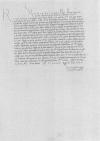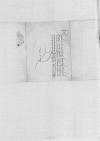Scire volumus
S(trenuita)tes or S(incerita)tes⌈S(trenuita)tesS(trenuita)tes or S(incerita)tes⌉ Vestras, quia magna cum instantia hic sumus petiti a nobili Anna Zukowska, filia quondam spectabilis Leonardi Fogelueder consulis Cracoviensis, quatenus eius negotium, quod apud serenissimum dominum Romanorum, Germaniae, Hungariae et Boemiae etc. ⌊regem⌋, consanguineum et fratrem nostrum carissimum, habet ratione certi debiti, videlicet novem millium trecentorum viginti et septem florenorum Hungaricalium eidem olim Leonardo, patri eiusdem Annae, debitorum, commendare dignaremur S(trenuitati)bus or S(inceritati)bus⌈S(trenuitati)busS(trenuitati)bus or S(inceritati)bus⌉ Vestris apud illius regiam maiestatem solicitan(tis). Cuius precibus, tum et aliorum consiliariorum nostrorum pro ea apud nos factis, annuimus non gravatim, quandoquidem sci{u}mus debitum illud liquidum fuisse. Unde committimus S(trenuitati)bus or S(inceritati)bus⌈S(trenuitati)busS(trenuitati)bus or S(inceritati)bus⌉ Vestris, quatenus de ea re cum ⌊sua maiestate regia⌋ ex parte eiusdem Annae Zukowska creditricis captato aliquo commodo tempore agant et nostro nomine commendent, ut sua maiestas se illi subditae nostrae exorabilem praestare dignaretur, quae hunc nuntium suum cum sufficienti instructione ad S(trenuita)tes or S(incerita)tes⌈S(trenuita)tesS(trenuita)tes or S(incerita)tes⌉ Vestras mittit, ex quo abunde se disponent de statu debiti sui. In qua re cum anno superiore ⌊maiestati suae⌋ pro eadem Anna Zukowska scripsimus, illius maiestas respondit tum illi clementem se velle eius debiti habere rationem, quando originales obligationis illius debiti litteras suae maiestati misisset, quas nunc per eum nuntium suum et affinem mittit. Ideo S(trenuita)tes or S(incerita)tes⌈S(trenuita)tesS(trenuita)tes or S(incerita)tes⌉ Vestrae ne desint istic illi, quo clementem relationem hac in re referant a ⌊maiestate sua⌋ et quidquid patrocinii in ea re S(trenuita)tes or S(incerita)tes⌈S(trenuita)tesS(trenuita)tes or S(incerita)tes⌉ Vestrae eidem Annae istic exhibuerint, erit nobis gratum studium S(trenuita)tum or S(incerita)tum⌈S(trenuita)tumS(trenuita)tum or S(incerita)tum⌉ Vestrarum.


 BNW, BOZ, 953, f. 167v
BNW, BOZ, 953, f. 167v